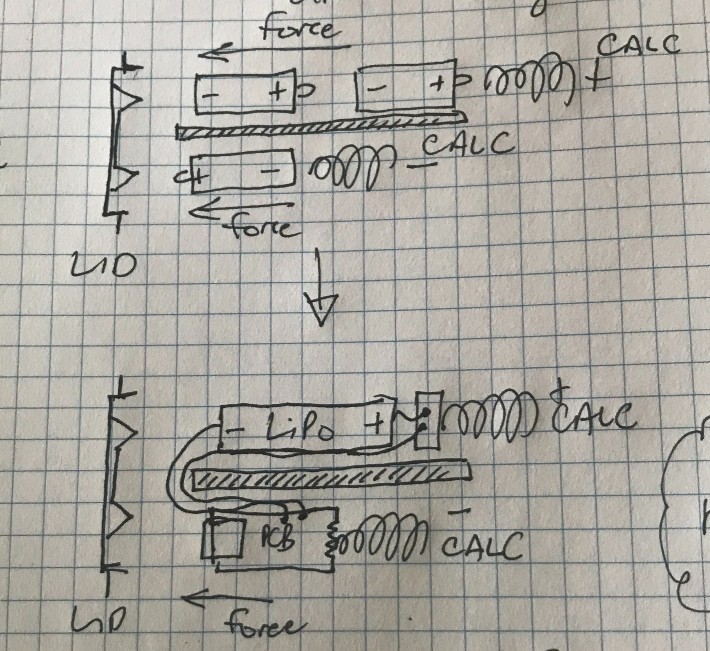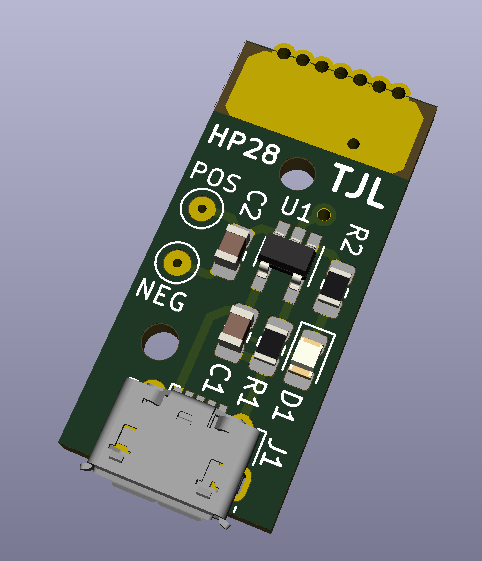The HP 28S is a nice calculator, but the battery solution is awful. I have made modern battery solutions for my HP Classic and Texas Instruments TI-59 calculators, which has given them new life. Can I do something similar for the HP 28S? because it really needs help in this department!
My inspiration came when I confiscated two e-cigarettes from a teen's bedroom earlier this year - but that's another story. After smashing the e-cigs to bits, I noticed that each had a cylindrical LiPo cell inside. I set them aside, thinking that at some point I'd have a use for them...
Fast forward a few months, and rediscovering my HP 28S calculator with its mangled battery cover. Hmmm.. I wonder if one of those scavenged LiPo cells would fit inside? Will the calculator work from one 3.7V cell? Could charging circuitry somehow be included?
Answers: "sort of", "yes", and "probably".
Here's my sloppy sketch of the idea:

The HP 28S has three N cells - all are in series, but there are two "tubes" side by side - upper tube holds two cells, and the lower holds only one. The inside end of the upper tube is where the positive contact lives, and the inside end of the lower is where you find the negative contact. The battery retention cover provides the "short" between the cells in the two tubes.
Each N cell is (approx) 12mm diameter x 28mm long. The scavenged e-cig LiPo is type EVE13450, which is (approx) 13mm diameter and 45mm long. It's a bit tight, but the 13mm cell just fits into the upper tube - my calculator has a strip of foam inside the upper tube that I might have to remove to make it fit the LiPo better.
The LiPo is approx 680mAh, which is a bit shy of the 800-1000mAh that Alkaline N cells provide, but better than the 500mAh that NiMh N cells offer. So long as it's easy to recharge, I don't see an issue with the slightly diminished capacity. The three N cells in series provide 4.5V, whereas the single LiPo cell provides 3.7V. The discharge curve of the LiPo is better, however; the 3.7V is pretty constant for most of the charge life. My tests have shown the HP 28S works from a 3.3V power supply very well so, again, no issue expected here.
Some sort of metal "stuff" is needed to bring the LiPo positive wire in contact with the metal contact spring inside the calculator - some metal foil taped to the end of the LiPo cell, for example, would probably work here.
The USB charger circuitry should live in the shorter lower tube. This is also where the calculator's negative terminal is, so contact needs to be made to that as well. Therefore, both LiPo positive and negative need to go to this PCB via some small wires. I think a small 3D printed "holder" or "base" might be needed to snugly locate the PCB into the lower tube and keep it in place when the USB cable is plugged-unplugged. The circuitry is trivial, exactly the same as that of my first HP Classic LiPo retrofit. The "ideal diode" is not required here, because the calculator will never see more than the single LiPo cell voltage (about 4V during charging - still under the 4.5V of three fresh N cells in series). I designed a PCB that is 12mm wide and 26mm long, with a negative contact castellated along the "inside" end of the PCB to make contact with the calculator's negative terminal spring. All together, the PCB looks like this:

The "POS" and "NEG" pads are for connection to the LiPo terminals. I left the soldermask off the inside end of the PCB in case my castellated end doesn't work and I need to attach some other sort of contact.
In theory, the only pressure on the battery retention lid will be the USB connector pushing against the inside of it, and I made the PCB 26mm long vs. the 28mm long N cell, so that should reduce the spring tension as well.
 tomcircuit
tomcircuit
Discussions
Become a Hackaday.io Member
Create an account to leave a comment. Already have an account? Log In.